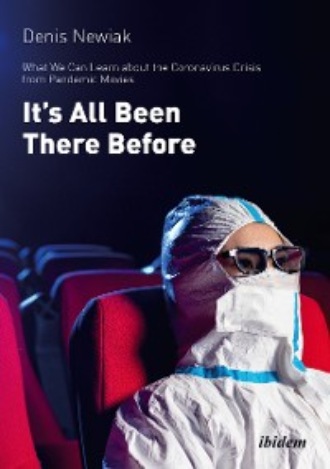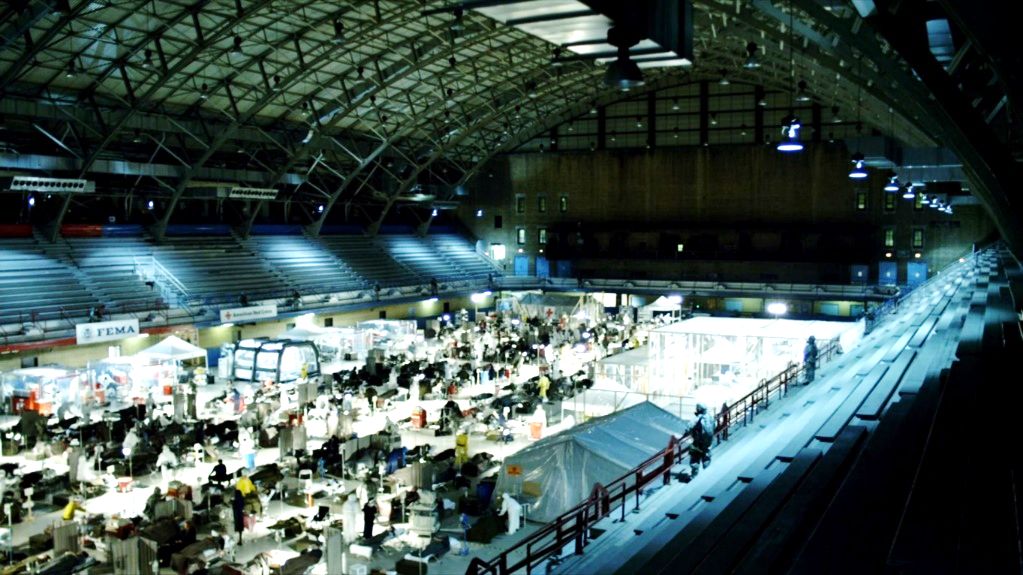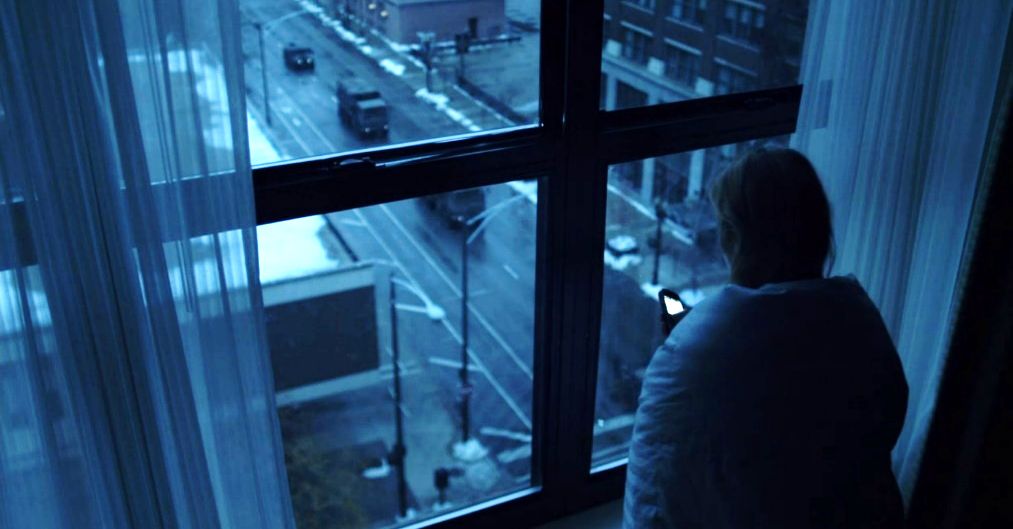
Полная версия
It’s All Been There Before

Figure 1: In Contagion (53), a supposedly unthinkable future already appeared almost 10 years ago, anticipating the horrors of the present with its emergency hospitals, mass graves, and criminal profiteers of crisis.
Films as an early warning system for crises and intuitive orientation aid for disaster situations
Against this background, pandemic films and series can also potentially offer orientation in dealing with the realworld challenges that are fictionally played out in them. Cinema films and television series – as phenomena of popular culture with a particularly broad impact – thus not only act as an ‘early warning system’ for possible social ills (for example, fundamentally inadequate preparation for pandemics) and future challenges (for example, coping with a pandemic under these deficient conditions). They also contain (aesthetically implicitly as well as narratively explicitly formulated) suggestions for coping with present and future questions (such as the appropriate social and individual behavior in the case of a pandemic), which the recipients have always used intuitively and often unconsciously to adjust to possible life situations. It is precisely the aesthetic game that, due to cinema’s stylistic differentiation, allows us to distinguish between developments that tend to be more desirable and undesirable: while film and television take a stand with their artistic means, they allow a discourse on whether certain developments are also desirable in social reality or should be avoided.
Science fiction as a method: Preparing for late modern challenges
State of emergency makes suspicious conditions of society visible
Against this background, science fiction scenarios are gaining importance and provide important social benefit. Precisely because of their tendency to thematize supposedly ‘improbable’ events, they allow not only an examination of what a society perceives as ‘normal,’ but also of how it reacts to its state of emergency, to the disturbance of social normality. In the sense of GROĬS (2000), it is precisely these critical moments of dysfunction, which first provide information about the true nature of a system that must always remain “suspect’ in the disturbancefree regular operation: in the moment of the state of emergency, previously invisible and suppressed areas of conflict, clashes of interests, antagonisms are revealed, which can only then be effectively dealt with and defused.
Science fiction allows to deal with hidden and complex issues
Works of science fiction are known to take up precisely such disturbances of our habits and to play through their effects on the social reality of the fictional characters’ life. Although the genre’s narrative worlds are always fictional realities (in contrast to scientific discourses), in Goodman’s words, “fiction operates in actual worlds in much the same way as nonfiction”: fictional works “take and unmake and retake familiar worlds, recasting them in remarkable and sometimes recondite but eventually recognizable – that is recognizable – ways” (GOODMAN 1978, 104–105). In this sense, the ‘real’ reality of our normal life that shimmers through them, is refracted and only then becomes visible. If the fictions of film and television remain ‘realistic’ enough (i.e. if they are sufficiently similar to our own life reality) so that a society can recognize itself in them, they allow us to deal with complex contemporary issues that cannot be adequately addressed in political, civil society and scientific discourse due to taboos, bias or simply cognitive overload (STEINBORN/NEWIAK 2020). Such filmic fictions “represent an explicitly fictional reality to which the observer can nevertheless orientate himself” and which allows the audience to “navigate better through the real world and the complexity of its relationships” (ESPOSITO 2014, 56). Thus, for example, the images and concepts of future urbanity in science fiction may neutralize problems of cities that already exist today by tapping the reservoir of urban future knowledge, social discourse lines and concrete designs contained in futuristic film cities, so they possibly can be used in local urban planning (KRÄMER/MAIKÄMPER/PÄTSCH ET AL. 2015).
The visualization of social complexity in film enables rational decisions to be made in reality
Works of science fiction, above all cinema and television series, refer to a core dilemma of late modernity: today, due to the increasing complexity of social, economic, and ecological dependent relationships, it is almost impossible to make reliable statements about the possible course of the future solely with the help of quantitative-empirical methods to “find a basis for consensus” (LUHMANN 1991, 57). However, parallel to the “growth of causal complexity, i.e. the multiplicity and diversity of causes and side effects” (LUHMANN 1991, 101), in late modernity, “the dependence on decisions and thus the attention value of the future is growing” (LUHMANN 1991, 53): anyone who wants to make rational decisions in the present, in the hope of desirable consequences in the future, is always dependent on knowledge of the coming, because one’s own actions must be measured by their possible effects and outcomes. Film and television with their “subjunctive narrative forms” (KIRCHMANN 2006, 167), their constant question of “what if?,” thus permit a speculative, but in their own way rational, empirical search for the not always obvious connections between causes and effects: film and television thereby reduce the otherwise overburdening complexity of social processes to humanly tangible standards, while at the same time demonstrating them vividly and making clear how actions in the present potentially affect the course of things (NEWIAK 2021). By doing so, they have a special role to play as a dynamic repository of knowledge about the future and action, particularly in view of such a challenging event as a pandemic (see fig. 2). Precisely because the social contexts become less and less transparent with progressive modernization and sometimes appear chaotic and arbitrary to the individual, cinematics can succeed in making social reality readable, at least in certain subareas, with regard to “effects and causes, or problems and solutions, questions and answers” (JAMESON 2005, 14).

Figure 2: In Contagion (45), Mears, a disease control officer, observes the arrival of the National Guard with similar horror as realworld television viewers in March 2020 perceived the Italian military convoys as an unmistakable sign of the beginning and escalation of the Covid-19 pandemic.
Pandemic films offer an intuitive experience of abstract scientific discourses
Even in the early stages, there was an outcry that civil protection scenarios on the possible future spread of a virus (such as the now infamous “Modi-SARS” risk analysis by the German Federal Office for Civil Protection and Disaster Assistance, Bundestag-Drucksache 17/12051 of 3.1.2013) have been ignored, and that opportunities to take precautionary and protective measures that are obviously necessary in the event of a pandemic were missed. Of course, such public scenarios and academic studies use another ‘language’ than popular culture, but in their essence, they have long since been drafted in popular pandemic film. Kate Winslet, for example, in her role as a staff member of the Center for Disease Control and Prevention (CDC) in Contagion (USA 2011), states: “A plastic shark in the movie will keep people from getting in the ocean, but a warning on the side of a pack of cigarettes…” (Contagion 19) – i.e. the warning from experts and public administration, on the one hand, often remain comparatively ineffective because it lacks concrete clarity, identification figures who need to act in realistic decisionmaking situations, and attention control through affects. Film and television, on the other hand, create an intuitive experience of possible scenarios that remain unreal and improbable in the theoretical description.
Film and television condense social questions, discourses and areas of conflict
Of course, such films are not to be taken literally: the evaluation of what is purely dramaturgical and entertaining in these films, what is productionrelated and what is (also) to be understood as a sociocritical and political comment, is usually made intuitively at the very moment of the reception experience. This special achievement of film and television in dealing with social issues in a dense aesthetic way cannot be surpassed by a short scientific treatise. However, this book – in view of the special situation – attempts to investigate in a condensed form, with the help of a film analytical-hermeneutic evaluation of selected representative works, how the individual elements of action can be classified in such film works – and which may in fact offer important indications of real-world fields of conflict that hardly ever appear in the public discourse.
Uncovering and using future knowledge and options for action from the pandemic films
The following striking analysis of some relevant works from film and television is intended to contribute to an application-oriented examination of the knowledge that the works of art contain about the possible courses of pandemics, their socio-economic implications and consequences and the associated regulatory, civil society and individual psychological challenges. Ideally, the scenarios developed by these films – which, as cannot be emphasized enough, follow predominantly their own rules of dramatization, fictionalization and economic evaluability and must not be misinterpreted as ‘mirrors of society’ – can help to support politics, civil society, and scientific actors who are overburdened by the mere thought of anticipating possible future developments (let alone by making approximate predictions). Only this allows to critically analyze possible intervention measures, to find new scope for action and to adapt and ideally sensibly expand their measures to combat pandemics – both now and in the future.
Films only submit offers – but those responsible must decide for themselves
At the same time, it must be underlined that – although the spreading Covid 19 disease triggered publication of this book – the findings described in the following are to be understood in general terms, and at the same time should be interpreted with caution. Neither should it be suggested that the described narratives must always be in a concrete connection with the currently prevailing crisis situation. Just because films and television suggest it that way, the presented behavioral offers and courses of action are not compulsory likely, socially desirable or even necessary. The decision on this is incumbent on those who are assigned this responsible role by a society.
Pandemic films focus on the most serious scenarios – an opportunity to prepare for future major threats
In addition, pandemic films typically deal with infection courses that are many times more severe, dynamic and effective than the Coronavirus disease which started in 2020. In accordance with the concrete and serious warnings of virologists, epidemiologists, and futurologists, even much more devastating pandemic scenarios can be imagined, which would present mankind with even more profound challenges. With this in mind, this text should also be understood as an invitation to consider the harsh social, economic, and legal cutbacks made in the course of the appearance of SARS-CoV-2 as a result of a lack of preparation for a possible pandemic. The accumulation of ever newer and more aggressive pathogens since the turn of the century suggests that people will probably have to deal with pandemics even more frequently in the future – and potentially also with event patterns that could significantly exceed the challenges existing at the time of writing this book. It is therefore worthwhile, both in the current situation and with a view to possible future developments, to deal with such fictions, because they envision what political leaders, citizens and even civil protectionists often cannot or do not want to imagine. Nevertheless, it remains the natural and exclusive task of the decisionmakers in power to weigh up what concrete effects the knowledge of such fictitious scenarios must have.
Конец ознакомительного фрагмента.
Текст предоставлен ООО «ЛитРес».
Прочитайте эту книгу целиком, купив полную легальную версию на ЛитРес.
Безопасно оплатить книгу можно банковской картой Visa, MasterCard, Maestro, со счета мобильного телефона, с платежного терминала, в салоне МТС или Связной, через PayPal, WebMoney, Яндекс.Деньги, QIWI Кошелек, бонусными картами или другим удобным Вам способом.



